
Photograph by Paul Lambert
“His poetry is indefinable but is laconic, occultist, and attached to the line of revolutionary and subversive yearnings.”
Andrew Duncan: A Poetry Boom 1990–2010
Paul Holman is the author of The Memory of the Drift, a shifting but ultimately circular work which was both a record of operations and a process in itself. A new edition, gathering writing made between 1991 and 2017, is now available from Shearsman.
A further collection, Tara Morgana, is available from Scarlet Imprint.
Sussex Coils and Loops is in preparation from the same publisher. Extracts have appeared in SNOW lit rev and The Fortnightly Review, and artwork and artefacts from the book have been exhibited at the Candid Arts Trust in London.
Holman’s significant education took place at Little Sparta.
He co-edited the Invisible Books imprint with Bridget Penney through the 1990s, publishing work by Bill Griffiths, Stewart Home, Veronica Forrest-Thomson and others.
He has read in the SubVoicive, Blue Bus, Xing the Line, CapLet and Hi Zero series, at the Cambridge Conference of Contemporary Poetry, Scarlet Imprint’s Pleasuredome and on Dublin’s Culture Night. He has appeared at the Poetry Cafe in Covent Garden on several occasions, and been broadcast on Resonance FM. He took part in the Fichtean Landscapes exhibition held in London in November 2022. A setting of his writing has also been performed by the loop-based vocal group Askew and Avis.
He is a long-standing member of the Field Study mail art group. Much of the material contained in The Memory of the Drift has its origin in Field Study Emanations, which have both supplied an occasion for his work and offered it a testing ground: the final text in the series appears in Field Report 2017.
“At the heart of this work there is a poem, but the poem is inseparable from the process of its composition, in much the same way that some of John Cage’s piano works are inseparable from the processes that were used to create them (think of the star charts in Etudes Australes). In the wrong hands such processes are an excuse for lack of creativity and little more than a pose. Here, as with Cage, there is something far more subtle going on: the interaction of an incisive creative talent with that process.”
Tony Frazer, Shearsman
“This is a poetry of returning, returning from the occult subterranean as a kind of echo. It requires to be read as a kind of translation, as if everything in each word echoes a place from which the word is coming back in a different language that nevertheless sounds the same. Like an echo, it is imperfectly rendered, misheard sometimes, headless at other times. There is no possibility of tidying the thing up, of housekeeping it into a finished, rounded up equation. It has the quality of sounds reverberating with other powers, places, tongues yet these occur without the taint of overblown rhetorical flourish that can sometimes ruin occult poetics and turn them into obscurantist rantings and self regard. This is a poetry that is tempered and disciplined but by energies that are older than the poet’s own experiences and knowledge.”
Richard Marshall, 3:AM Magazine
“… it’s the worlds of magick and of Late Modernism, apparently diverse, yet both system-dependent operations. What brings them together is that also both employ the language of speech-acts—spells or rules—language that effects the world. Or can.
Both sets of actions, magic and art-making, derive from the obsessive rituals we need in a fragmented world to hold it (or don’t I mean ourselves?) together. The fragmentation is integral to Holman’s project—a wonderful variety of forms, of fluid voices and characters.
… we create our rituals with what is there: the cultural detritus and the ground it’s placed on. We don’t do ‘traditional’ of course, and I include Holman with his resort to bricolage and fragmentation in that. We’re out of the Neolithic, in some age of vast cultural flux, ethnogenesis and confusion, a weird repeat of the ‘Dark Ages’.”
Peter Philpott, Geometer
“Bold, modern and really rather English with a hint of the gothic / pagan.”
Nick Telfer, PN Review
